What is Buy Online Pickup In Store (BOPIS)?
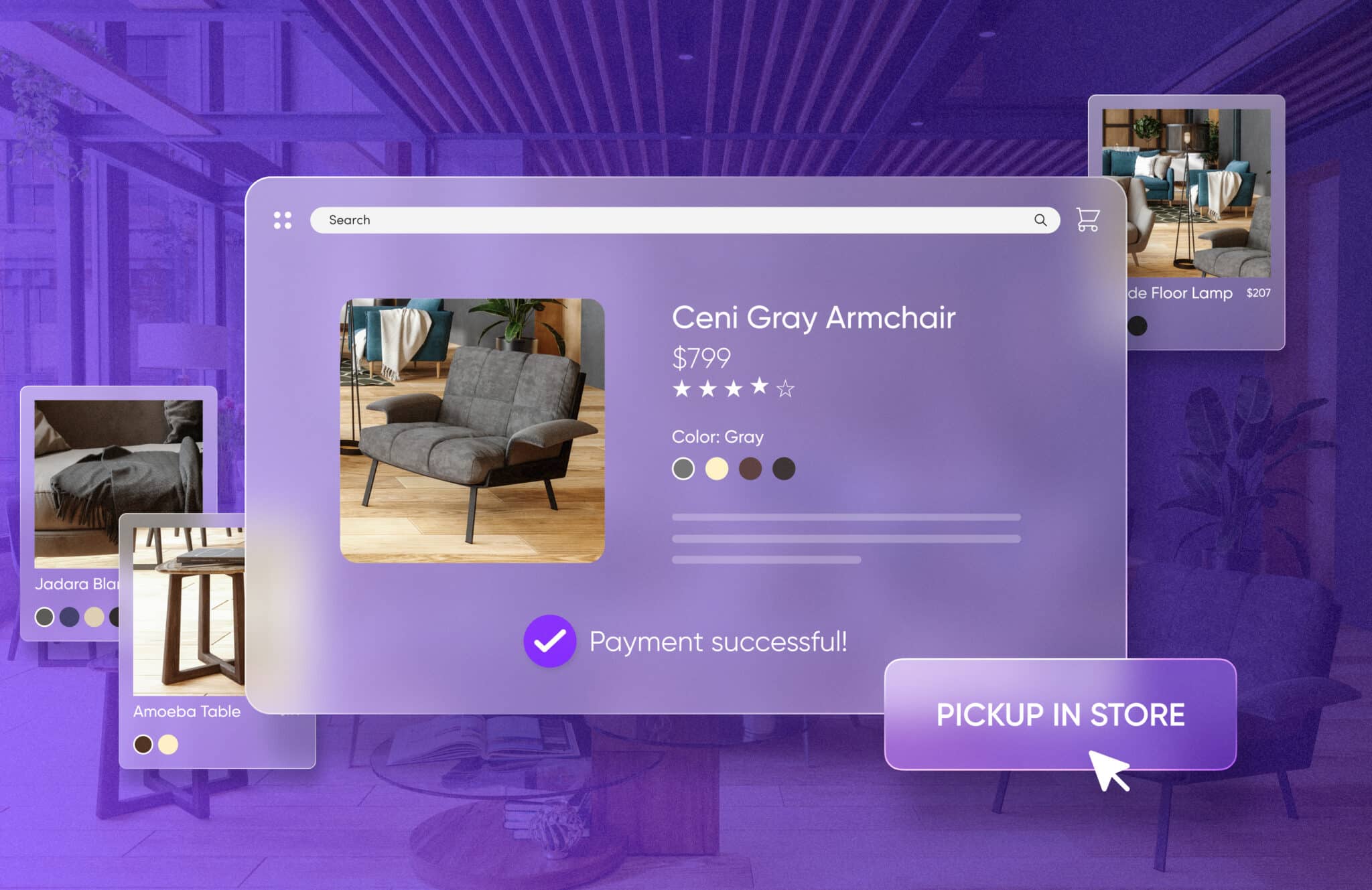
BOPIS or buy online, pickup in-store is a popular omnichannel fulfillment strategy that allows customers to make purchases online and collect their orders from a physical store location.
Retailers enjoy many benefits when offering BOPIS, some of which include increased conversions, increased foot traffic and cross-selling opportunities, and reduced shipping expenses.
Implementing BOPIS requires seamless integration between online and in-store operations, optimized inventory management, and a frictionless pickup experience.
fabric OMS simplifies inventory and order management for retailers and supports omnichannel fulfillment strategies including BOPIS, ship from store, and curbside pickup.
The Complete BOPIS Guide for Omnichannel Retailers
BOPIS stands for “Buy online, pickup in-store.” It’s a potent omnichannel fulfillment approach that retailers are rapidly adopting.
Enterprise retailers are in constant pursuit of new ways to enrich the customer experience—whether it’s prioritizing faster fulfillment, optimizing for consumer convenience, or enhancing personalization along the buyer’s journey.
BOPIS, has gained significant momentum in recent years and continues to grow in popularity. BOPIS existed before COVID-19, but the fulfillment strategy became an even bigger advantage during the global pandemic as a way for retailers to offer contactless delivery. According to research by eMarketer, click-and-collect sales jumped by 104.5% from 2019 to 2020. It grew to $73.16 billion in 2020 and is expected to soar to $154.3 billion in 2025, accounting for 9.6% of total e-commerce sales.
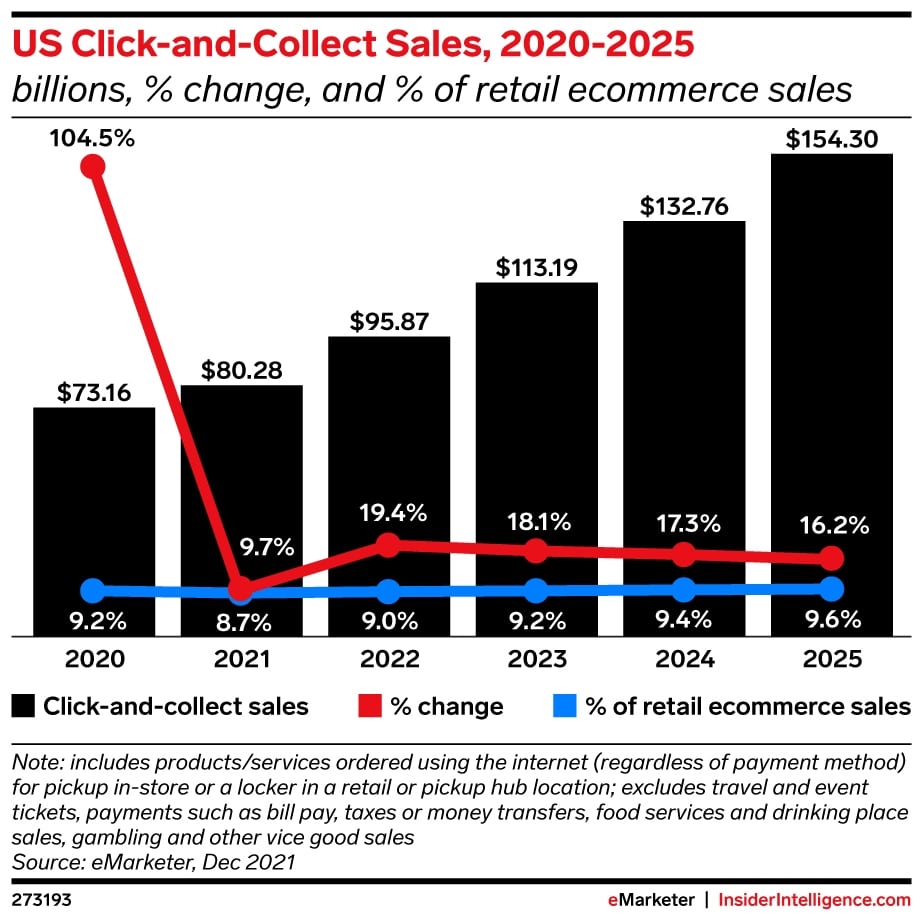
BOPIS sales have increased steadily since 2020.
Today, BOPIS is viewed as a must-have for retailers because it has rapidly become a win-win omnichannel fulfillment strategy: customers avoid shipping costs, save time, and enjoy better product availability, while retailers can increase their in-store foot traffic, boost operational efficiency, and save money on distribution. A great example is Walgreens, a company that recognizes that their customers want more convenience. They’ve invested heavily into BOPIS and home delivery, and in 2022, the company completed 35 million pickup orders and one-hour deliveries from its stores.
BOPIS is clearly an opportunity worth pursuing. The question is, what’s the best way to implement this fulfillment strategy to realize its many benefits?
In this guide, we’ve compiled all you need to know about BOPIS for omnichannel retailers. Continue reading to discover the ins and outs of BOPIS, its operational mechanics, its advantages for enterprise retailers, and strategies to optimize the impact of your BOPIS implementation.
[toc-embed headline=”What is BOPIS?”]
What is BOPIS?
BOPIS, short for buy online, pickup in-store, is an omnichannel fulfillment strategy in which customers make a purchase online and then pick their orders up at one of the retailer’s physical stores at a time of their choosing.
BOPIS is one of many “online to offline” (O2O) strategies retailers use to meet rising customer expectations and to lower shipping costs. Some other O2O approaches include:
- ROPIS: Reserve online, pickup in-store
- BORIS: Buy online, return in-store
- BOPAC: Buy online, pickup at curb (also known as curbside or “trunk” pickup)
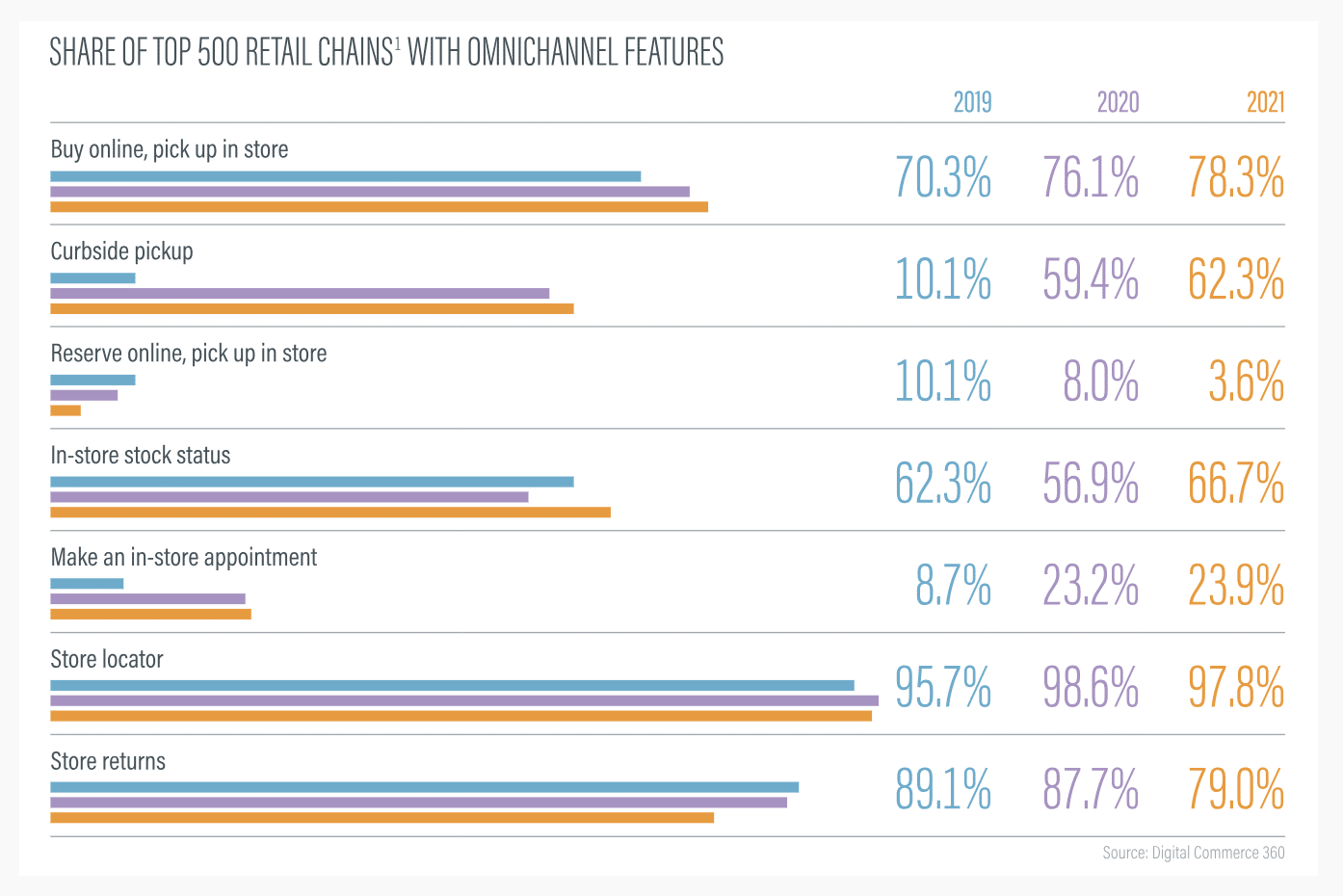
Top 500 retail chains with omnichannel features.
Digital 360’s 2022 Top 500 Report found that the offering of BOPIS and curbside pickup among retailers soared higher from 2019 to 2022 in order to meet customer demand. Adding more physical retail locations to a retailer’s fulfillment network helps improve product availability and gives customers the flexibility to pick up their orders whenever and wherever is convenient for them.
[toc-embed headline=”How BOPIS Works”]
How BOPIS Works
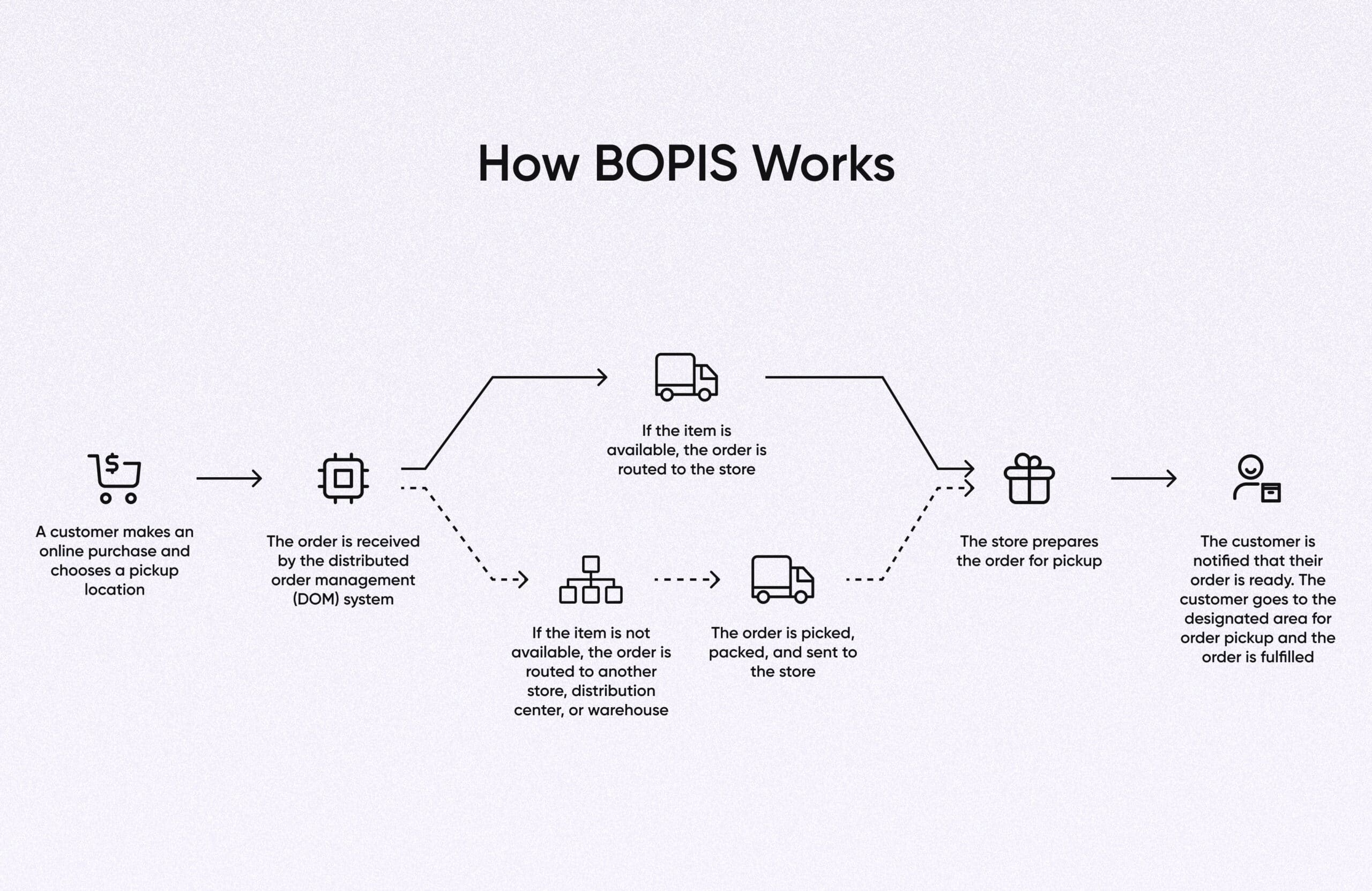
Behind the scenes, there are several steps that need to happen for retailers to deliver a seamless BOPIS experience to consumers.
BOPIS is a fairly straightforward process for the customer, but there’s more happening behind the scenes. Here’s how a typical BOPIS order works:
1. A customer makes a purchase online
The BOPIS process kicks off when a customer places an order on a retailer’s website or mobile app. If the retailer provides this option at checkout, the customer can decide that they want to pick up the order in-store, and can select a pickup time and store that best fits their location and schedule.
For BOPIS to work, retailers must ensure seamless coordination between their online platform and physical stores, while having real-time inventory visibility and availability, efficient order processing, and clear communication channels with customers. Having a centralized system to sync inventory across the network and set up real-time inventory controls reduces the chances of an item being out of stock when a customer tries to order and pick up an item in-store.
2. The order is received by the OMS and order processing begins
Order processing is the series of steps that a business follows to fulfill a customer’s purchase in a fast, efficient manner. A distributed order management (DOM) system will begin processing the order by routing it to the desired location according to the business logic or rules set by the retailer.
3. The order is routed to the store for fulfillment
If the item is in stock, the DOM system routes the order to the designated store.
3A. The order is routed to a different facility for fulfillment
If the item is not in stock, the DOM system routes the order to a different store, distribution center, or warehouse facility, where the item is picked, packed, and then sent to the designated store.
4. The store prepares the order for pickup
If the item is in stock, store employees will pick and pack the item and prepare it for pickup. If the item is routed to the store from a different location, the order is simply prepared for pickup.
5. The customer is notified that their order is ready and the customer completes the order pickup in the designated area
A notification with instructions is sent to the customer, letting them know that their order is available for pickup. Retailers often have a designated customer service counter or a specific area of the store for storing and completing BOPIS orders. When customers arrive, an associate will ask them to present a QR code, text, or confirmation email, along with a form of ID. If everything matches, the customer leaves with their order in hand. Some retailers may use a locker system for fulfilling BOPIS orders as well.
[toc-embed headline=”Benefits of BOPIS for Consumers”]
Benefits of BOPIS for Consumers
Immediate product availability
Today’s customers want near-instant gratification, and BOPIS delivers convenience. Instead of waiting days or weeks for their order, they can have it in their hands that same day they place an order — sometimes even in a few hours. Generally when they place an order for pickup, they know with high confidence that it will be ready for them.
Convenience
Some customers may want to avoid shopping in a busy store. BOPIS gives customers flexibility in their busy days — they can pick up their orders whenever and wherever it’s convenient for them. They can also save time on returns as well. Customers have the ability to inspect their order in-store and if there is an issue with the product, they can immediately exchange it for something else or process a return.
Shipping costs
Because customers are picking up their orders in-store, they no longer have to pay shipping costs. This is significant because many enterprise retailers, including Abercrombie & Fitch, Saks Fifth Avenue, Neiman Marcus, and Macy’s, have recently upped their minimums for free shipping on deliveries. Another added benefit is that customers don’t have to worry about the security and condition of their items—two major problems associated with shipping and deliveries. According to Statista, below are the top reasons consumers opted for BOPIS in 2021:
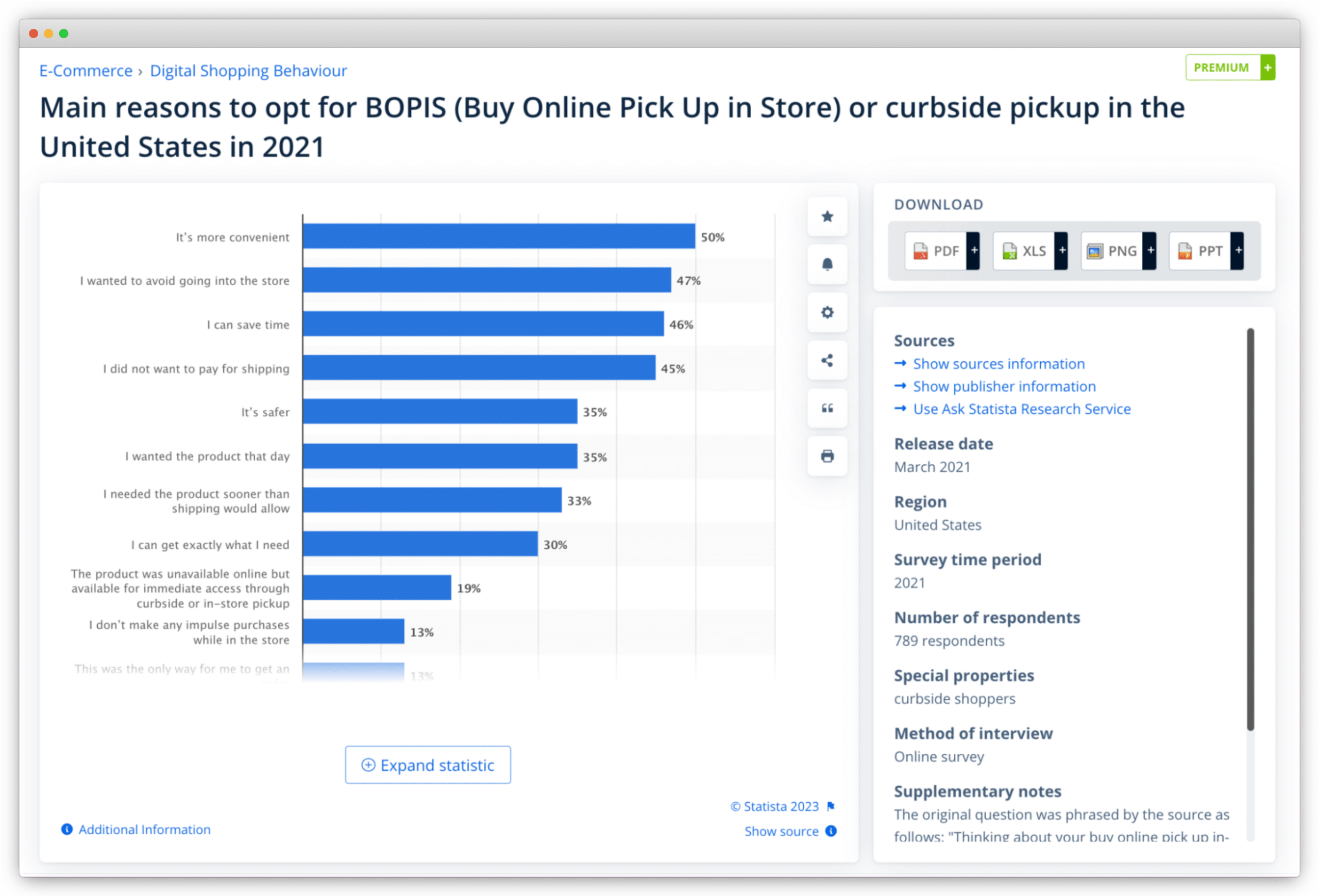
Top reasons why consumers choose BOPIS.
[toc-embed headline=”Benefits of BOPIS for Retailers”]
Benefits of BOPIS for Retailers
Increased conversions
Many retailers fear that offering BOPIS and other omnichannel fulfillment strategies will lead to cannibalization of in-store sales. However, the opposite is often true, with convenient shopping options not only driving higher online conversions but also higher sales overall.
Lindsay Mikos is the senior director, retail omnichannel at Walgreens. When asked about the potential of BOPIS to cannibalize in-store retail sales, here’s what she had to say:
“That’s always been the biggest fear, but it doesn’t. It actually drives incremental value. They spend more money with us. We’re able to engage with them more often and give them more relevant offers… We’re continuing to see it; it’s double digit growth. It’s a key driver of our overall digital growth.”
Having an integrated approach bolsters overall sales, strengthens customer engagement, and solidifies the retailer’s omnichannel presence.
Increased foot traffic and cross-selling opportunities
BOPIS increases foot traffic by encouraging customers who place online orders to visit the physical store for order pickup, providing opportunities for enhancing overall engagement.
When consumers enter the store to pick up their items, they may be exposed to other products that catch their eye, especially if they are on sale. Impulse buys and encouraging in-store purchases with discounts and incentives can greatly boost sales. According to Retail Dive, 85% of shoppers have made additional in-store purchases while visiting stores to pick up what they bought online, and 15% have done so “somewhat frequently”.
Reduced shipping expenses
Shipping is pricey. 47% of retailers say they spend over 10% of an order’s total value on shipping. Furthermore, due to the impact of Amazon, most consumers aren’t willing to pay a delivery fee. 66% of consumers say shipping costs are their “biggest online shopping pet peeve”. BOPIS optimizes inventory management by leveraging existing store locations as pickup points, eliminating the need for last-mile deliveries and shipping fees.
[toc-embed headline=”Implementing BOPIS: Examples and Best Practices”]
Implementing BOPIS: Examples and Best Practices
Chico’s FAS
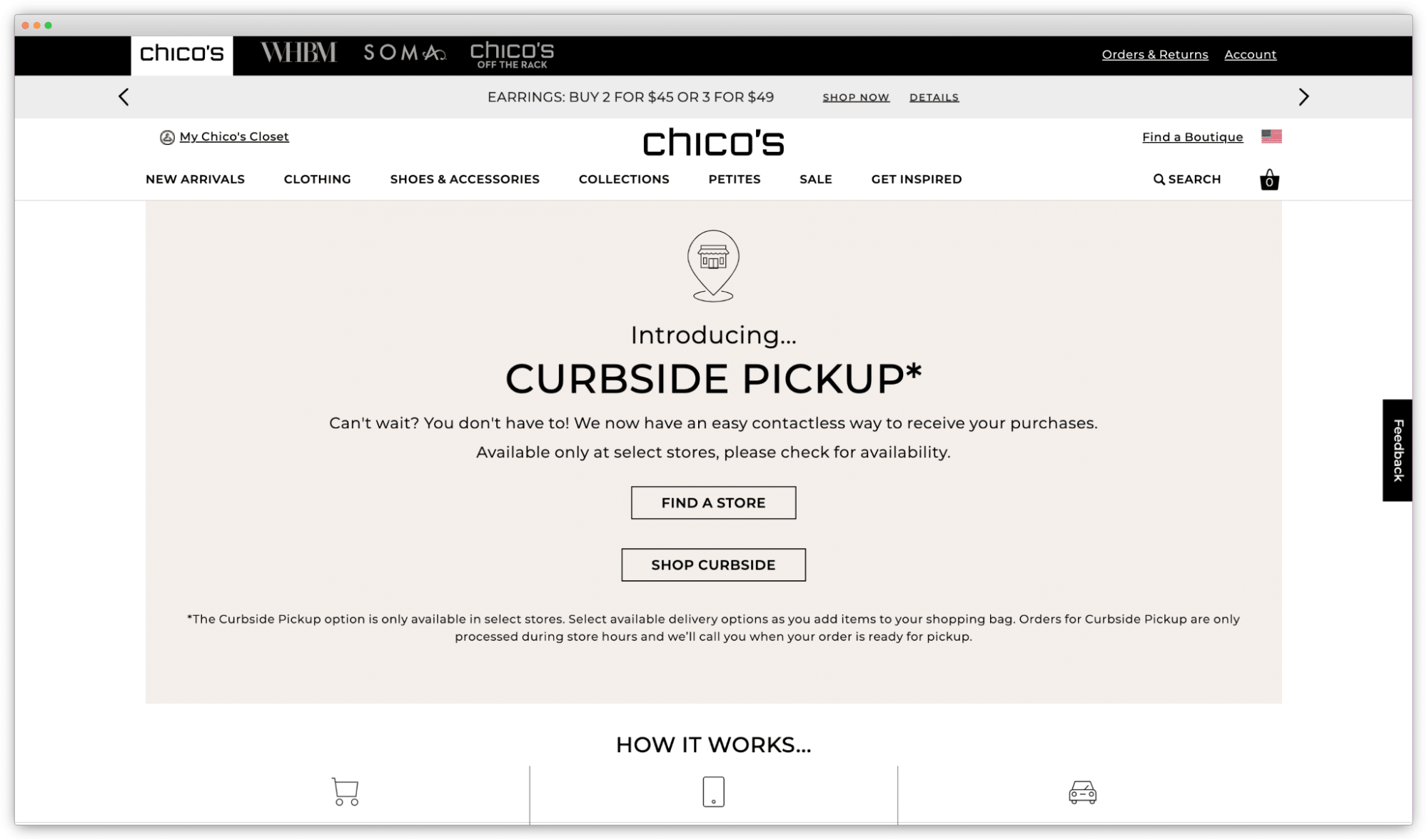
Chico’s implemented a BOPIS strategy and invested heavily into their omnichannel capabilities.
Chico’s FAS is one of the leading women’s fashion retailers in North America. The company has not only strengthened its offerings with BOPIS, curbside pickup, and delivery, but they’ve also improved performance by investing heavily in their omnichannel capabilities so their customers can fully experience their brands in the manner they choose.
Omnichannel customers are more valuable in terms of lifetime value (LTV). On a recent earnings call, Chico’s FAS’ President and CEO Molly Langenstein said that:
“What we’re seeing in particular is our focus on being able to grow the multi-channel customer, and that has been strategic. What we saw this past quarter is that our customer crown accounts for multichannel customers grew by 9% and that spend per customer for the omnichannel customer grew by 17%. That customer is three times more valuable to us than a single-channel customer.”
Nordstrom
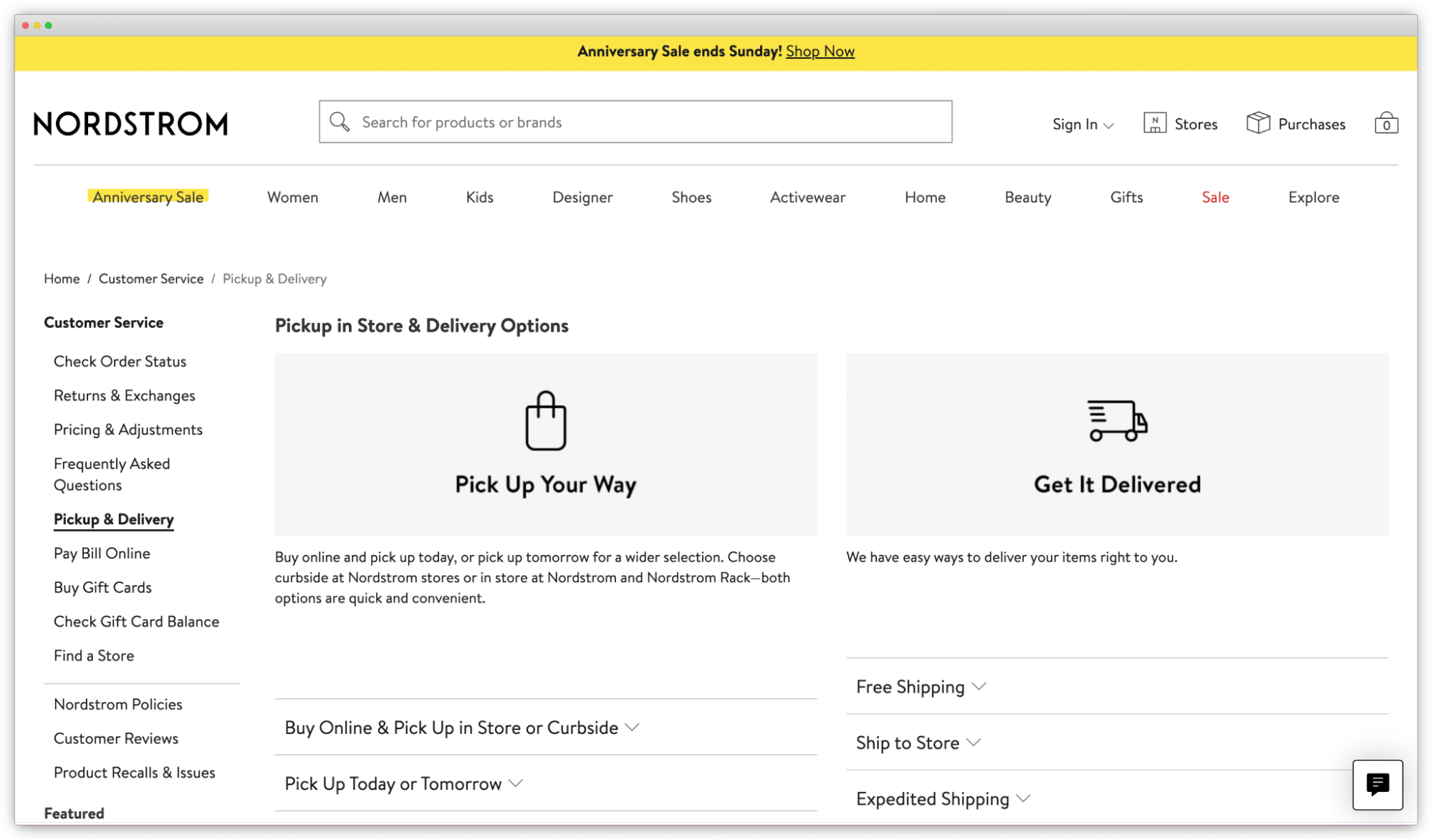
Nordstrom expanded their BOPIS services into many Nordstrom and Nordstrom Rack locations.
According to research by McKinsey, Nordstrom successfully connected digital and physical product offerings in its top ten markets, resulting in a fourfold increase in the selection available for next-day delivery. Additionally, the retailer expanded BOPIS services to cover not only their 100 Nordstrom stores but also their 249 Nordstrom Rack locations. According to Nordstrom CEO Erik Nordstrom:
“I can’t imagine anybody knowing for sure what will happen in the future—the takeaway is that our businesses have to be agile and flexible.”
Dollar General
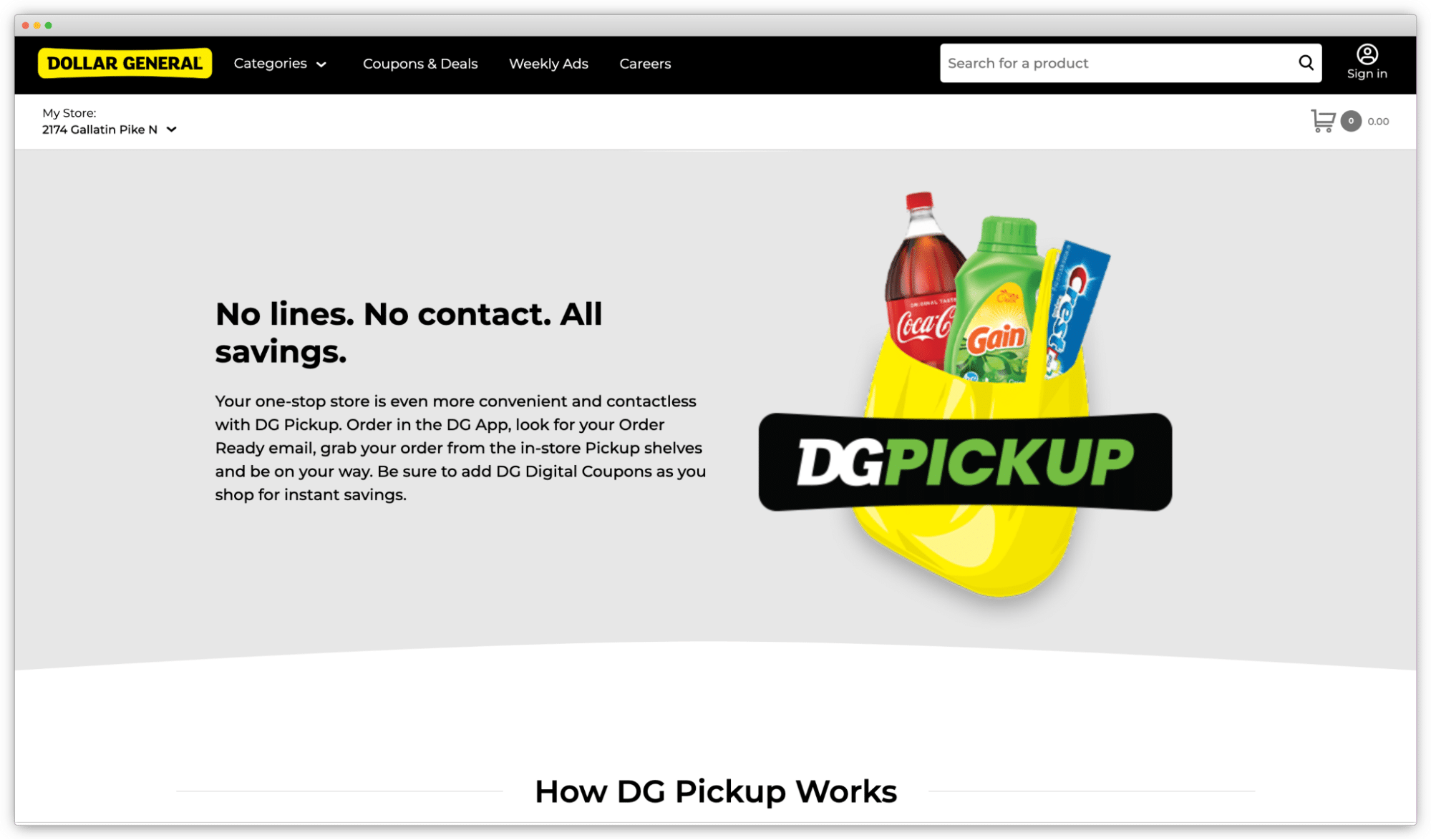
Dollar General expanded its contactless delivery options by expanding its BOPIS initiative.
Dollar General has rapidly expanded its contactless shopping capabilities with DG Pickup, combining the launch of its BOPIS initiative—in 17,000 stores in just nine months—with the rollout of an app with scan-and-go technology. Dollar General CEO Todd Vasos said:
“For us, some e-commerce priorities that were previously five years out are now more on a three-year horizon. We need to more quickly understand how to satisfy the consumer and accelerate our timelines accordingly.”
BOPIS critical success factors
Reaping the many benefits of BOPIS requires significant investments in time, training, and technology. To implement BOPIS effectively and realize cost savings, increased revenue, and enhanced customer satisfaction, retailers can follow these best practices:
1. Measure KPIs
Retailers should define essential performance indicators to assess the success and effectiveness of their BOPIS implementation. These metrics may include order fulfillment time, customer satisfaction ratings, order accuracy, and conversion rates. Monitoring these key indicators allows businesses to make data-driven decisions and continually optimize their BOPIS strategy.
2. Create a testing program
Implementing a robust testing program can help to assess the BOPIS process. Businesses can test for website usability, order placement, payment processing, and in-store pickup flow. The results can be used to identify any bottlenecks or pain points in the customer journey and make necessary adjustments to improve the BOPIS experience.
3. Collect feedback from employees and customers
Retailers should gather feedback from both store associates involved in BOPIS fulfillment and customers who have utilized the service. Employees can help identify operational challenges and opportunities for streamlining the process. Customer feedback allows you to understand their experiences, expectations, and pain points, enabling you to make smart and targeted enhancements that boost customer satisfaction.
4. Implement training for store associates and customer service representatives (CSRs)
By developing training programs for store associates and CSRs, businesses can ensure they are well-equipped to handle BOPIS orders efficiently and deliver exceptional customer service. Training should cover order processing, inventory management, communication skills, and handling potential customer issues or inquiries related to BOPIS. Well-trained staff contribute to a seamless BOPIS journey, which can lead to strong customer loyalty and repeat business.
5. Use order management and inventory management software
Retailers need modern inventory and order management software to ensure they can fully support BOPIS. Look for distributed order management (DOM) systems with real-time inventory visibility and availability, adjustable inventory controls, and customizable logic-based rules for order fulfillment. Modern order management systems offer a mobile application to support efficient store operations for BOPIS.
Your tech stack should also be able to track available-to-promise (ATP) inventory — stock that’s ready to sell and hasn’t yet been allocated for existing customer orders. To do that, you’ll need to integrate in-store inventory availability with your online store via API or other connections. Your systems should also allow you to automate manual processes with standardized workflows as much as possible.
[toc-embed headline=”Overcoming BOPIS Challenges”]
Overcoming BOPIS Challenges
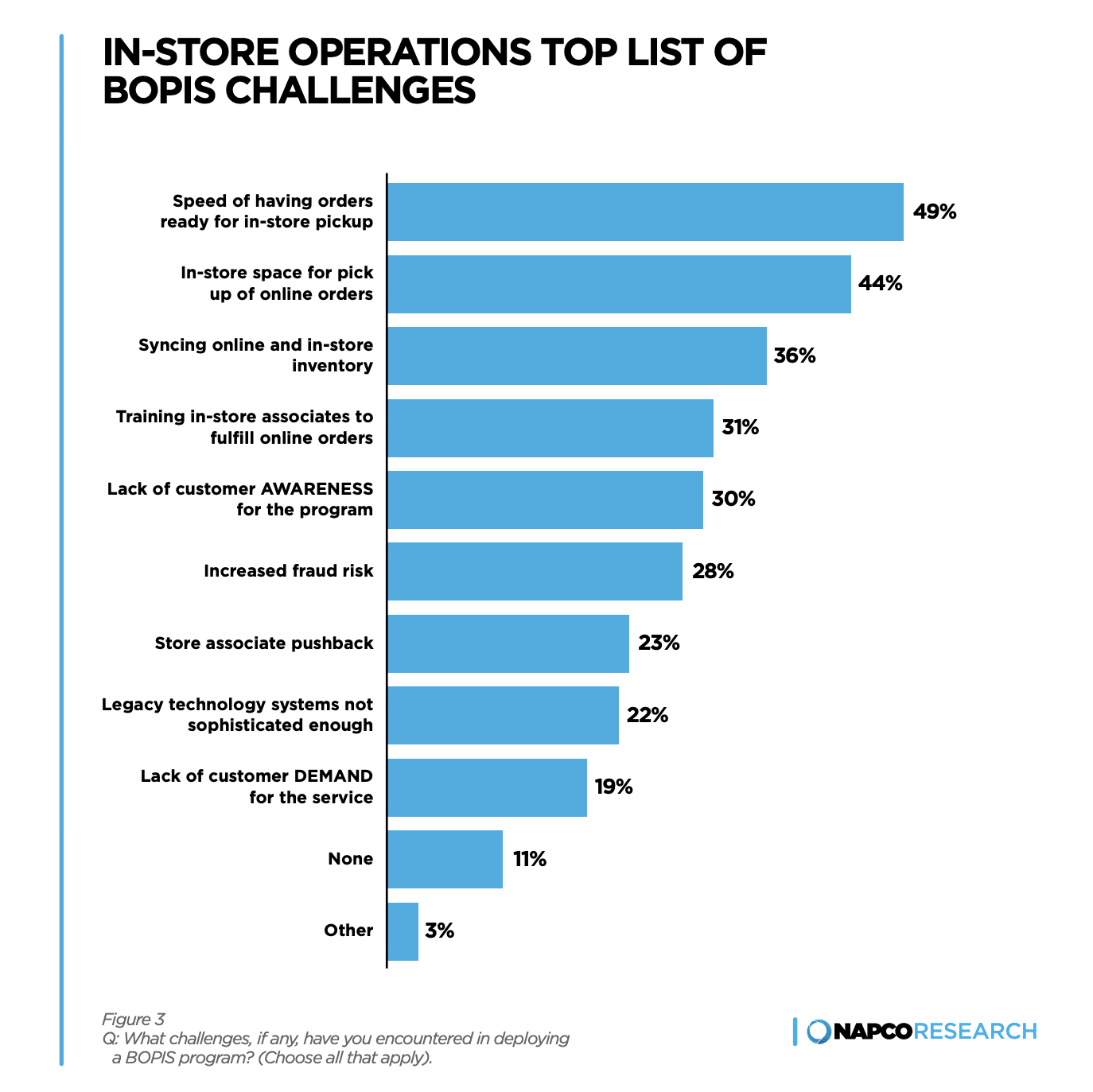
Challenges faced by retailers when implementing BOPIS.
Although BOPIS can confer major benefits, it also comes with challenges. According to NAPCO Research, in-store operations are the biggest hurdles for BOPIS implementation. Two other major issues include:
Speed and in-store efficiency
The whole point of BOPIS is to offer a seamless online-offline experience that keeps customers coming back to your store. Yet 56% of retailers say they suffer from strained store capacity, and 54% say they deal with increased operational and staff challenges. Without dedicated storage and floor space and a tight internal process, it’s difficult for a BOPIS program to scale.
Real-time inventory visibility and inventory syncing
Customers expect to be able to pick up their items when retailers say they will be available. But 57% of retailers say they have trouble maintaining in-store stock availability.
For BOPIS to work, businesses require real-time inventory visibility across the entire network. However, they often can’t get accurate updates without an integration between their e-commerce platform and their inventory and order management systems. And without a robust warehouse and distribution process, store associates can’t quickly order and replenish low stock when they need to.
Addressing challenges
Technology solutions can help to overcome some of these hurdles. Enterprise retailers that want to offer BOPIS or improve their existing BOPIS program need to evaluate and adopt a modern order management platform for better order lifecycle management. An OMS with DOM capabilities should support BOPIS use cases and offer inventory visibility, order fulfillment orchestration, and native integrations to their e-commerce platform.
[toc-embed headline=”fabric OMS Supports BOPIS and Omnichannel Fulfillment”]
fabric OMS Supports BOPIS and Omnichannel Fulfillment
fabric OMS helps enterprise retailers streamline their inventory and order management processes across all fulfillment channels, increasing speed and quality of delivery while decreasing delays and limiting stockouts.
The platform’s native network aggregation capabilities provide real-time inventory visibility, enabling the order routing logic you need to power BOPIS, curbside pickup, and ship from store fulfillment methods. These backend features benefit the end customer but also free up developer resources for strategic projects and reduce strain on customer service representatives.
If you’re looking to enhance your customer experience and drive operational efficiency with omnichannel fulfillment, sign up for a demo with the fabric OMS team today.
[toc-embed headline=”BOPIS FAQ”]
BOPIS FAQ
What are the differences between Reserve Online, Pickup In-Store (ROPIS), Buy Online, Pickup In-Store (BOPIS), Buy Online, Return In-Store (BORIS), and Buy Online, Pickup At Curb (BOPAC)?
BOPIS, ROPIS, BORIS, and BOPAC are all related to BOPIS. Each one is a different fulfillment option that caters to specific customer needs and enhances the overall retail experience. Here’s what each of them means:
- BOPIS enables customers to complete the entire purchase online and pick up their orders in-store, avoiding shipping fees or delays.
- ROPIS allows customers to reserve products online, ensuring availability for later pickup in-store. It suits customers who prefer a hands-on experience before making a final purchase decision, particularly for larger items like furniture, electronics, or other appliances.
- BORIS allows customers to return products purchased online to a physical store, making returns and exchanges hassle-free.
- BOPAC gives customers the option to order online and pick up their purchases curbside in a designated section of the store parking lot.
What is the difference between BOPIS and curbside pickup?
BOPIS and curbside pickup are two different fulfillment options enterprise retailers can offer their customers.
With BOPIS, customers purchase items online and then collect their orders from a designated physical store. Curbside pickup is a specific implementation in which customers drive to the pickup location, but remain in their vehicles while their order is brought out to them. Curbside pickup is contactless and convenient, making it particularly appealing during times of social distancing or if customers have limited mobility.
Is BOPIS the same as click-and-collect?
There are similarities between BOPIS and click-and-collect, but they aren’t the same thing.
Click and collect is a broader term that refers to the overall process of customers making purchases online and then collecting their orders in person. This can include options like curbside pickup or locker pickup in addition to in-store pickup. BOPIS is considered a type of click-and-collect option where customers purchase items online and collect them from a designated physical store.

Digital content editorial team @ fabric